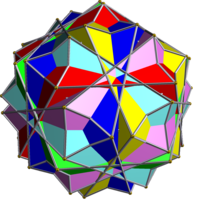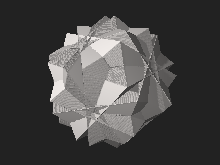Compound of six pentagonal antiprisms
The compound of six pentagonal antiprisms is a uniform polyhedron compound. It's composed of a symmetric arrangement of 6 pentagonal antiprisms. It can be constructed by inscribing one pentagonal antiprism within an icosahedron in each of the six possible ways, and then rotating each by 36 degrees about its axis (that passes through the centres of the two opposite pentagonal faces).
| Compound of six pentagonal antiprisms | |
|---|---|
 | |
| Type | Uniform compound |
| Index | UC27 |
| Polyhedra | 6 pentagonal antiprisms |
| Faces | 60 triangles, 12 pentagons |
| Edges | 120 |
| Vertices | 60 |
| Symmetry group | icosahedral (Ih) |
| Subgroup restricting to one constituent | 5-fold antiprismatic (D5d) |

3D model of a compound of six pentagonal antiprisms
It shares its vertex arrangement with the compound of six pentagrammic crossed antiprisms.
Cartesian coordinates
Cartesian coordinates for the vertices of this compound are all the cyclic permutations of
- (±(3 + 4τ), 0, ±(4 − 3τ))
- (±(2 − 4τ), ±5τ, ±(1 − 2τ))
- (±(2 + τ), ±5, ±(4 + 2τ))
where τ = (1 + √5)/2 is the golden ratio (sometimes written φ).
gollark: I mean, a significant part of my socialization is done with random people over the internet (especially *now*), which may have something to do with it.
gollark: it just means "really progressive".
gollark: I actually have a cool interactive visualizer tool for the political compass results of 10 people on a discord server I'm on.
gollark: What?
gollark: Wow, he actually *is* politically opposite to me 8values-wise.
References
- Skilling, John (1976), "Uniform Compounds of Uniform Polyhedra", Mathematical Proceedings of the Cambridge Philosophical Society, 79: 447–457, doi:10.1017/S0305004100052440, MR 0397554.
This article is issued from Wikipedia. The text is licensed under Creative Commons - Attribution - Sharealike. Additional terms may apply for the media files.